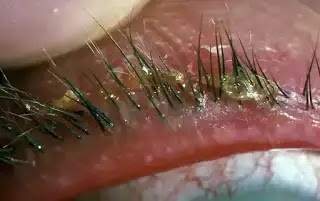What is Blepharitis? (Types,symptoms,Treatment)
Blepharitis is an inflammation of the eyelids often close to the base of the lashes. It usually occurs when tiny glands between lashes become blocked.
Blepharitis
is the inflammation of the eyelids. The eyelid is folds of skin that keep the eye safe from debris and injury on the edge of the lids are lashes with short curved
hair follicles containing oil glands. Blepharitis commonly occurs when the tiny
oil glands located on the edge of the eyelids become clogged or irritated
resulting in red eyes the condition usually occurs in both eyes and involves
the part of the eyelid. Where the
eyelashes grow, it is a common condition
that can develop at any age but is more prevalent in young children and people
older than 50 years of age.
These blocks often produce a crusty or oily appearance with flaking of the skin around the eyelid. The lid themselves may become red and swollen. Blepharitis may cause a gritty burning or itchy sensation while uncomfortable. Blepharitis does not result in permanent eye damage.
Blepharitis is not sight
threatening for example it will not cause permanent damage to the eyesight. However, it can result in permanent alterations of the eyelids margin the condition can be uncomfortable and unsightly. But it is not contagious if left
untreated. Blepharitis can lead to
- excess tearing
- difficulty wearing contact lenses
- development of stye
- conjunctivitis and
- corneal ulcer
Causes
Causes the exact cause of the condition is hard to determine but different factors can increase the risk of getting the condition. This may include- dandruff of the scalp and eyebrow or seborrheic dermatitis
- eyelash mite or lice
- bacterial infections
- poor hygiene
- when using cosmetic products
- exposure to smokes fumes pollutants and certain chemicals
- allergens such as allergic reactions to certain eye medications or contact lens solution
- malfunctioning of the meibomian glands
Types
- Bacterial Blepharitis
- Seborrhoeic or squamous blepharitis
- Mixed staphylococcal with seborrhoeic blepharitis
- Posterior blepharitis or meibomitis
- Parasitic blepharitis
Symptoms
- itchy eyelids irritated and
- watery eye redness loss of eyelashes
- sensitivity to light
- eyelashes that grow abnormally
- flaking and crusting of the area around
- the base of the eyelid burning or
- stinging eyes sticking of the eyelids
- frequent blinking
- Lash loss
- Discharge
Diagnosis
The doctor will carry out a physical examination. During the physical examination the doctor will carefully examine your eye and eyelid the the doctor may use a slit lamp which is a specially developed low-power microscope with an intense beam light source in certain cases, the doctor may collect a swab sample of the oil or crust that forms on your eyelid this sample can be analyzed for bacteria fungi or proof of an allergen.
Treatment
- Washing your eye and applying warm compresses
- Prescription medications to fight infections which are available in various forms including cream augments and eyedrops
- Prescription medications for inflammation such as steroid eye drop electromechanical lid margin debridement such as bleph X treatment to effectively remove bacteria mites and open clogged meibomian glands
- Intense pulsed light or IPL therapy to open clogged island' glands
- Thermal pulsation therapy such as lipiflow to melt any material obstructing the meibomian glands
- Blepharitis caused by seborrheic dermatitis maybe controlled by treating the underlying condition.
- The condition can be a recurring problem the best way to keep the condition from coming back is to clean the eyelids daily to prevent bacterial, eye mites from building up on the eyelid margin.
How to clean eyelid
- wash your hands moisten a washcloth or cotton swab with the cleaning solution
- wipe eyelashes and lid margin do this gently
- rinse with water repeat the same process for your other eye using a different washcloth or cotton swab




Comments
Post a Comment
If you have any doubts, please let me know